Wittgenstein and the Arts: Nuno Venturinha in Conversation with Dr Gindi
Exploring the Relationship between Wittgenstein and the Arts
By Nuno Venturinha, NOVA University of Lisbon
Ludwig Wittgenstein was not just one of the greatest philosophers of the 20th century, but he also left a lasting imprint on the world of arts. His manuscripts combine ground-breaking philosophical ideas with insightful perspectives on various artistic disciplines, such as architecture, cinema, literature, music, and sculpture, inspiring scholars and artists worldwide. However, Wittgenstein occasionally ventured beyond theory and emerged as a creator himself. While he is best known for the Kundmanngasse house he built for his sister Margarete Stonborough in Vienna from 1926 to 1928, in collaboration with the architect Paul Engelmann, a pupil of Adolf Loos, he also dabbled in sculpture during this period. Frequenting the studio of Michael Drobil, he fashioned a bust of a young woman, often associated with Marguerite Respinger and known simply as Head of a Girl. This piece is a formidable example of Wittgenstein’s engagement with the arts, revealing a captivating interplay between his intellectual genius and artistic spirit, capable of illuminating human nature even when philosophy falls silent. It comes as no surprise that first-rate artists drew inspiration from Wittgenstein’s philosophical concepts, embracing his unconventional views and crafting works that echo his distinction between saying and showing. The sculptor Dr Gindi is one of these artists who found solace in Wittgenstein’s unique teachings, harnessing his ideas to transcend traditional boundaries and experiment with new forms of expression. Her work vividly demonstrates that Wittgenstein’s influence extends far beyond philosophical theory, providing fertile ground for the evolution of artistic “language games”. Although Wittgenstein believed that works of art should speak for themselves, he extensively wrote on the topic and engaged in discussions with colleagues, friends, and students. Wittgenstein’s overarching strategy, which became a hallmark of his mature philosophy, was to resist explanation in favour of description. The following conversation preserves this fundamental principle, inviting the reader into the fascinating world of Dr Gindi’s sculptures, populated by objects that defy the confines of meaning and follow their own rules. She is a critically acclaimed sculptor who exhibited globally.
Nuno Venturinha: In what ways does your work, Dr Gindi, embody the influence of philosophical ideas, specifically the impact of Wittgenstein’s views on the intricate relationship between art and philosophy? Could you provide specific examples of how his concepts manifest in your sculptural creations and the deep grammar they strive to convey?
Dr Gindi: I agree with Wittgenstein that the world is everything that is the case. The world is an infinite universe we human beings are thrown into, for good or bad. The totality of facts in such a universe is something over and above a pure collection of things. Even though the Wittgensteinian legacy is often reduced to logic and language I see clear metaphysical rudiments in his Tractatus and specifically in his Philosophical Investigations. His thinking about metaphysics revolves around infinity as a result of a not stopping procedure, a kinetic world full of energy. Still, the obvious account of Wittgenstein’s and my intentions is not to solve philosophical problems and to ultimately answer the question of how we humans meander in that world. Rather, our aim is sedative, maybe even figurative in a rather withered tone. When seeking to bring together art and philosophy it is all too easy to confuse them or lose sight of what is most interesting about each. To all intents and purposes, my sculptural work shall invite a philosophical connection without depending on it – I intentionally do not want to engage in detached armchair theorizing. But the connection has always been there, since I was illuminated by the world outside of Plato’s cave – as philosophy is embedded in everything, including the arts. Or, as Wittgenstein has put it, the aesthetic dimension meshes itself through all of philosophy. That’s why Plato proposed a multi-dimensional view of reality, the World of Becoming and the World of Being. These worlds are preceded by the World of Fluctuating – a world in creation, in chaos, as it is difficult to say where we begin and where we end. Plato referred to the pre-Socratic philosopher Heraclitus who famously said that everything flows (panta rhei), and nothing is fixed. The World of Becoming is the physical world we perceive through our senses, seen from a cave, filtered through the entering light. Such reality is fractured, incomplete, and sometimes threatening. The World of Being is the world of ideas, or metaphysics as Plato’s student Aristotle accurately summed it up. Metaphysical desire within the World of Being illustrates a conviction that something is missing from our fractured reality – the inexplicable infinite. And, as Wittgenstein alluded to in his Philosophical Investigations, infinity can be approached by ignoring the muddying effects of everyday contexts. The desire to reach infinity surpasses all other desires when time slows down and elation is luculent. That’s why infinity is what concerns me most, in my sculptural work and in my own spell within the world.
NV: In your artistic creations, you have explored human genesis and drawn inspiration from both philosophical and scientific ideas. Through your series of sculptures, you delve into the essence of motion, the boundaries of the world, and the pursuit of infinity. How does each series represent these ideas? And how do they resonate with Wittgenstein’s perspective on language and its influence on our understanding and expression of the infinite?
DG: While interpreting Plato, I have developed three series of sculptures that are tightly interconnected as they are part of the circle of human genesis: Fluidity of Being, Fractured Reality, and Finding Ways. Firstly, we are swept into a kinetic performative that emanates from indeterminate matter in motion. The world is full of fuzzy boundaries, and there is no such thing as linear causality, as quantum physicists rightly observed. The characters I depicted in Fluidity of Being are not casks we can touch but rather turbulent compressions of energy. Panta rhei. Secondly, the series Fractured Reality seeks to recite dialogic prose to illustrate inner discontents, detaching us from the possible reclamation of infinity. As human beings, we are caged and imprisoned by what we call our reality, a perforated shadow that is shaping our existence. The characters shown in Fractured Reality are concerned with the discovery of the causes of their misery, they are their own enemies against which they battle. Finally, with Finding Ways, I endeavor to launch a universal inquiry into the existential arousal of infinity and its tonic value. The characters in that series trust themselves to find ways into the infinite, overwhelmed by their sheer verve for life, it is raw and excruciatingly palpable. Infinity, for them, means being unending, unlimiting, and unremitting. Infinity is what they make of their existence. Or, with Wittgenstein, what they make of the language they inherited and use.
NV: In your sculptures, the characters exude a sense of restlessness, capturing the transformative moments of life and the enigmatic phenomenon of death. Could you elaborate on how your artwork portrays these profound experiences? Moreover, how do these representations align with Wittgenstein’s view, as presented in the Tractatus, that death cannot be perceived as an event within the realm of life? In what ways do your sculptures reflect and interpret this notion, bridging the gap between the finite and the infinite?
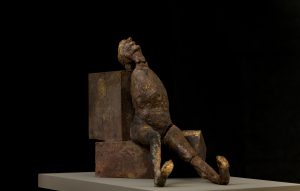
DG: In contrast to Plato, I believe that the transitions from one to the other state of human existence are not final nor self-contained, they appear simultaneously, without end. Such simultaneity might explain why many of the characters in my sculptures appear restless: but also, oddly placid in the moment of transition. They indulge in their infinity. They are fluid, fractured, and foundational – all at once. Such synchrony emphatically ties with Wittgenstein‘s understanding of existence in the Tractatus – ‘the solution of the riddle of life in space and time lies outside space and time’. Practically, all characters could be in one series or the other, but I identified the one which is closest to their being strung together in a singular moment. Take The Last Second which appears in Fluidity of Being: Everything vanishes for a forlorn character in the last movements of life. The grammar of perception got an appalling twist whilst delving into the shelves of decay, fluid as it is. Nothing matters anymore, in that fractured reality where the character silently implodes. But there is a resurging desire and tenacity of life whilst searching for the truth of being. In a last surge from the world of appearances, that perishing fellow might enter a rather serene espousal of that collective space of consciousness. Death is not the end of life but rather the assumption of a different dimension. Experiencing death with fascination, as if our palls could entangle the eternal breathing of our souls. And for us, who timidly love life, infinity is the way to carry us beyond the cage of insularity.
NV: Your work reflects a profound connection not only with philosophers but also with scientists who have significantly influenced our comprehension of the human condition. What stands out is how your sculptures, while prompting contemplation of existential questions about identity and purpose, manage to convey a sense of hope. Considering the immense scale of the universe and our limited understanding of it, do you ever feel overwhelmed or intimidated by the vastness of existence and the limited insights we can glean from it?
DG: I find philosophy not to be intimidating. On the contrary, I feel like a soulmate with many cartographers of the human condition. For sure I am influenced by Wittgenstein and his vigorous, plus analytical, thinking. He opened up for me an understanding of what holds the world together in its inmost folds. And I adore his skepticism and process of gaining understanding: ‘You have to throw away the ladder after you have climbed up it’ – an act always happening to me when I finish a sculpture. My feeling of familiarity with Wittgenstein is perhaps also due to the poetic tone in which he shares his observations with the reader. I am also influenced by Einstein and the quantum physicists who defined space and time as emergent fluctuations of energy. Furthermore, Freud and Jung with their psychoanalytic theories are crucial to me as they pioneered insights into the Self – and opened the pathway toward the understanding of unconscious motivations. Likewise, my characters often look isolated, struggling with matters of identity and meaning. But I am not remaining there, I am striving to provide perspectives that do not automatically appear, though they are not a given, they have to be endorsed – here is where metaphysics begins for me. My characters want to overcome their fractured reality to discover their nature of being and to find purpose in a callous world. Let me make the point that metaphysics is the foundation of all reasoning, with contributions of figures such as Aristotle, Hegel, and Deleuze, and even the existentialists who saw metaphysics as ontology. Their trains of thought lead us into an indefinite yet indefinitely open future.
NV: Your work concentrates on the disruption of life’s balance and its resulting consequences. How does this exploration of the human condition through sculpture offer unique insights into the concept of infinity, rivalling the contributions of metaphysics itself?
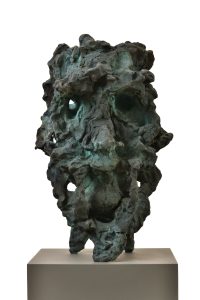
DG: I am a gestural person, so let me explain the human condition with my fingers: Two of my fingers are snapping in the abyss. Where do we go? What will we see? Are we going to lose our innocence, our virginity? Are we guilty, by every act we do? Snap your fingers and examine your life as Socrates famously insisted. It is not enough to merely understand and examine the reality that surrounds us. We shall also understand and examine the reality that dwells within our own souls. Such introspection shall ease us to make amendments to our life’s course, if need be, and may even spur us to make intrinsic changes to our unfolding path. When the balance in life is disturbed, contentment inevitably plunges into the trouble-filled state of terror – as exemplified in Terrified!, a recent work in Fractured Reality. The character I created feels mercilessly trapped. There is a sense of unrest that is undisguised and detectable, his essence is filled with hollowed-out mud. Hidden in petrified desire, he is daunted by the glow that buries his underground caves. Driven by the fractured reality around and within us, we are often sliding away into gloom and misery, ultimately wrecking ourselves. The frightful reality of things is our everyday discovery. Hence, I wish for the characters I am modelling to make the right choices in their lives, to unearth what is beneath the surface. I want them to discover their own metaphysics. And, ultimately, I want them to reach infinity, a realm beyond our fissures and fractures. Infinity – for me – is also a metaphor for having the bravery to seize the unprecedented and to allow it to unfurl into life. Searching for meaning becomes palpable.
NV: Your sculptures beautifully depict characters suspended in an infinite universe, blurring the boundaries of space and time. How does the incorporation of quantum physics in your artwork challenge conventional concepts of space, time, and observation, ultimately deepening our understanding of existence?
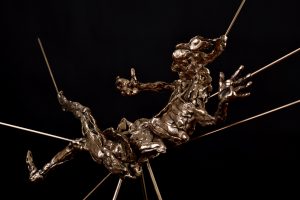
DG: I’ll try to be as clear and succinct as possible to explain the human floating in a universe that is infinite. Have a look at Flying into Life, an exemplary sculpture of the series Fluidity of Being: A seemingly relaxed character sinks to the earth, elegantly flying, cruising the breeze. His aligned zest descends back to his erstwhile belonging. Reflecting on perspective – a fictional rearview mirror in hand, he is a ray projecting from the eclipse. At first glance, the character is just a humanoid flying object. But because the character continues in our imagination to erratically move whilst landing on his imaginative runway, space and time quickly shed their meanings and become complete abstractions. I used quantum physics as a jumping-off point to illustrate that we can always fly into life, notwithstanding if we are – in our naïve perception – momentarily chained to outside restrictions. Our floating is a continuous movement of matter depending on the observer. The fluidity of being is an experience of reality beyond its physical imprint, whether we are actually in it, or imagining it. Well, it is difficult to say where we begin and where we end. We don’t know where our soul is dwelling, as it is everywhere. Our matter is driven by curiosity – we are our own stellar system in a huge galaxy. And yet we are united.
NV: Your exploration of suffering characters and the pervasive sense of absence reflects a keen awareness of our fractured reality. Considering Wittgenstein’s interest in psychoanalysis and his remarks on Freud, to what extent does your portrayal of fear draw upon psychoanalytical perspectives?
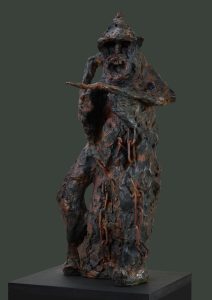
DG: I am aware of the fractured reality we are living in as I am – blisteringly and unyieldingly – often drawn to tormented characters full of contradictions. I hence created a whole series on the omnipresent sense of our own estrangement. Everything strains the protagonists in the series Fractured Reality, even those things that don’t. Their bliss is as painful as their agony. Look at Fear is hunting you: A nameless lurch stirs us with piercing fury. Appallingly, there is no need for unbearable screams. The arising silence around him grows grey with darkness, deep in the deep. But his chained corpse is fed by a ghastlier fear of the unborn dawn. We seem to be caged by fear as we have lost our inner self, our identity – we are not indistinguishable from ourselves as we have not yet learned to manage fear. It’s not just the fear of the tiger in the jungle stalking us, it is the very palpable fear about what other people think of us, in our absence. The series Fractured Reality indicates the presence of an absence. Whether we like it or not, we have to deal with such absence because it is dealing with us. Our fractured reality is determined by what Freud called our unconscious. Fear and other phobias are merely caused by unconscious desires stemming from earlier experiences. I somehow agree with such a scientific convergence but I would rather follow C.G. Jung who desired to humanize the conditions of being – for him, the collective unconscious is an inborn instinct that all of humanity shares, to a lesser or greater degree. I wouldn’t go so far as to say that suffering is necessary to bring about meaning. Let me state that reality is a human construct that drives our behavior, and we have the freedom to construct a world where fear and hence suffering have no space.
NV: I think it is fair to say that metaphysics, from Plato onwards, gives you a theoretical framework to unveil the nature of things and our search for meaning and infinity. How do your sculptures capture the essence of transcendence and this search for meaning, inviting viewers to contemplate the nature of reality and our longing for a deeper understanding?
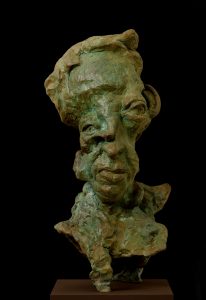
DG: There is nothing so revealing as Plato’s Allegory of the Cave, to help us find meaning in life, beyond the fractured reality in our underground caves. The allegory illustrates two important things. First, it represents Plato’s reasoning of the nature of reality and his understanding of essence. Second, it is a revelation in what metaphysics does: it reveals the true nature of things, and our very personal epiphany – as the sun illuminates everything once we leave the cave. When engaging with metaphysics, we vanish into the dark. Plato’s world leads directly to Aristotle who lashed metaphysics to the ground, examining the being of beings that possess substance, purpose, and ways of enlightenment. Plato’s world also directs us – albeit over several centuries and with some detours – to what French modernist philosopher Gilles Deleuze called the Metaphysics of Infinity – the affirmation of chaos and the ontological inconsistency of reality as such. It also directs us to the Tractatus where Wittgenstein stated that limits to human thought cannot be drawn because that would involve thinking on both sides of the limit, including the unthinkable. We thus need to consider the vast unthinkable, the infinite. In that sense, to get back to your central question, let me explain the search for meaning and the yearning for infinity with my sculpture The Horticulturist, with which I wanted to carve out reality at its joints. At variance with Deleuze and other metaphysicians, I do not want to make use of a set theory, but prefer an intuitive and qualitative approach to the infinite, staying close to the ethereal end of the spectrum. I sculpted an enlightened naturalist who has committed his whole life to the pureness of plants, germinating his infinite self. Prolific seeds of ardor he planted that should by now be grown, nourished by sun and water. The Horticulturist’s yearning for infinity made him an alluring creature that can only be deciphered through the enticement in the viewer’s eyes. His infinite substance can be understood as an airy realization of the Absolute. For sure, the Horticulturist found his way. He is the plant where things are felt or smelt.
NV: Finally, to wrap up, your views highlight the interconnectedness of sculpture and philosophy as indispensable expressions of reality. How does this blending of artistic and philosophical viewpoints prompt you to contemplate the relationship between aesthetics and the fundamental purpose of life? Is your creative process a philosophy of sculpture?
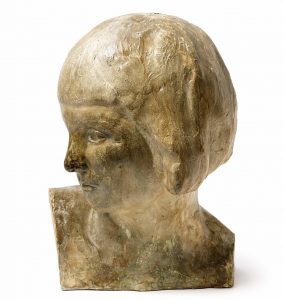
DG: That’s a great question with which to end our conversation but I don’t have any panacea to offer – as I feel that sculpture and philosophy are an expression and extension of reality. Both have been everlasting since humans existed and are two aspects of the same phenomena. I am convinced Wittgenstein would agree. And please think also of Plato: his dialogues are great works of philosophy, and can easily be interpreted as pieces of art, two-dimensional ones, and – with a bit of phantasy – three-dimensional ones as well. It is rather congruent that those who do one should do the other – it’s surprising there aren’t more of us declaring to be philosopher sculptors. By the way, and that’s very interesting: Wittgenstein himself created a sculpture known as Head of a Girl. An exhibition catalogue described it as ‘philosophy made into matter… an attempt to draw a line connecting ethics and aesthetics’. The philosopher-sculptor aspect of life is so zany, nurturing us to quit the fizz of our bafflement. In its wake, I feel or do not feel what existence really means. But I know that infinity is the purpose of life. Fluctuating, Becoming, Being.
Dr Gindi Website

